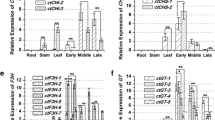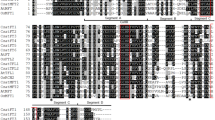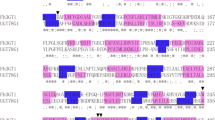Abstract
Safflower (Carthamus tincorius L.) is an economically important plant. Flowers are a source of dyes and active ingredients in medicines. The development of flower-specific promoters is of great significance for the directed regulation of the biosynthesis of targeted products. However, few flower-specific promoters have been reported in safflower. In this study, transcriptome analysis of various safflower tissues was performed. A total of 40.37 Gb of clean data were obtained, and 100 safflower-specific genes were screened. Three genes (CtFSG1, CtFSG2 and CtFSG3) were identified by RT–PCR, and all had high expression in flowers. The promoters of the three genes (pCtFSG1, pCtFSG2 and pCtFSG3) were cloned, and the promoter sequences were analysed. Promoter activity analysis showed that pCtFSG2 had suitable promoter activity in protoplasts of tubiform floret in safflower. This promoter specificity was further characterized by Agrobacterium-mediated transformation of pCtFSG2::GUS to Arabidopsis thaliana. The results showed that GUS staining was detectable only in flowers. Moreover, deletion analysis of the pCtFSG2 promoter region revealed that the DNA segments from − 1953 to − 1534 and − 980 to − 490 are critical for the expression of pCtFSG2. Our results indicated that pCtFSG2 is a flower-specific promoter with suitable promoter activity in safflower, which has potential value for directional modification of safflower.







Similar content being viewed by others
Abbreviations
- GUS:
-
β-Glucuronidase
- CHS :
-
Chalcone synthase gene
- CtFSG :
-
Flower-specific genes in safflower (Carthamustincorius L.)
- SON-PCR:
-
Single oligonucleotide nested PCR
- CDS:
-
Coding sequence
- LUC:
-
Luciferase
- SRA:
-
Sequence read archive
- qRT–PCR:
-
Real-time quantitative RT–PCR
- DAA:
-
Day after anthesis
References
Antal Z, Rascle C, Fèvre M, Bruel C (2004) Single oligonucleotide nested PCR: a rapid method for the isolation of genes and their flanking regions from expressed sequence tags. Curr Genet 46(4):240–246
Azuma M, Morimoto R, Hirose M, Morita Y, Hoshino A, Iida S, Oshima Y, Mitsuda N, Ohme-Takagi M, Shiratake K (2015) A petal-specific InMYB1 promoter from Japanese morning glory: a useful tool for molecular breeding of floricultural crops. Plant Biotechnol 14(1):354–363
Benfey PN, Chua NH (1990) The cauliflower mosaic virus-35S promoter-combinatorial regulation of transcription in plants. Science 250:959–966
Bowers JE, Pearl SA, Burke JM (2016) Genetic mapping of millions of SNPs in safflower (Carthamus tinctorius L.) via whole-genome resequencing. G3-Genes Genomes Genet 6:2203–2211
Chen J, Tang X, Ren C, Wei B, Wu YY, Wu QH, Pei J (2018) Full-length transcriptome sequences and the identification of putative genes for flavonoid biosynthesis in safflower. BMC Genomics 19(1):548–560
Chen J, Yi Q, Song Q, Gu Y, Zhang J, Hu Y, Liu H, Liu Y, Yu G, Huang Y (2015) A highly efficient maize nucellus protoplast system for transientgene expression and studying programmed cell death-related processes. Plant Cell Rep 34(7):1239–1251
China TSPCo (2015) Pharmacopoeia of the People’s Republic of China Part I. Chemical Industry Press, Beijing, p 151
Chiou CY, Wu K, Yeh KW (2008) Characterization and promoter activity of chromoplast specific carotenoid associated gene (CHRC) from Oncidium Gower Ramsey. Biotechnol Lett 30:1861–1866
Christensen AH, Quail PH (1996) Ubiquitin promoter-based vectors for high-level expression of selectable and/or screenable marker genes in monocotyledonous plants. Transgenic Res 5:213–218
Daraselia ND, Tarchevskaya S, Narita JO (1996) The promoter for tomato 3-hydroxy-3-methylglutaryl coenzyme A reductase gene 2 has unusual regulatory elements that direct high-level expression. Plant Physiol 112:727–733
Guilley H, Dudley RK, Jonard G, Balazs E, Richards KE (1982) Transcription of cauliflower mosaic-virus DNA-detection of promoter sequences, and characterization of transcripts. Cell 30:763–773
Hu YF, Li YP, Zhang J, Liu H, Chen Z, Huang Y (2011) PzsS3a, a novel endosperm specific promoter from maize (Zea mays L.) induced by ABA. Biotechnol Lett 33(7):1465–1471
Imai A, Takahashi S, Nakayama K, Satoh H (2013) The promoter of the carotenoid cleavage dioxygenase 4a–5 gene of Chrysanthemum morifolium (CmCCD4a-5) drives petal-specific transcription of a conjugated gene in the developing flower. Plant Physiol 170:1295–1299
Kulkarni DN, Revanwar SM, Kulkarni KD, Deshpande HW (1997) Extraction and uses of natural pigments from safflower florets 4th Intl. Safflower Conf. 2–7 June Bari Italy, pp 365–368
Lescot M, Déhais P, Thijs G, Marchal K, Moreau Y, Peer YVD, Rouzé P, Rombauts S (2002) PlantCARE, a database of plant cis-acting regulatory elements and a portal to tools for in silico analysis of promoter sequences. Nucleic Acids Res 30(1):325–327
Liu Y, Lou Q, Xu W, Xin Y, Bassett C, Wang Y (2011) Characterization of a chalcone synthase (CHS) flower-specific promoterfrom Lilium orential‘Sorbonne.’ Plant Cell Rep 30:2187–2194
Lou ZQ, Liu ML (1956) A pharmacognostical study of the Chinese drug Honghua Carthami tinctor II. Acta Pharm Sin 4:233–239
Ren C, Tang X, Chen J, Wu YY, Wu QH, Waang L, Wang Q, Pei J (2018) Cloning and analysis of promoter regions of flavonoid biosynthesis genes in safflower. Plant Mol Biol Rep 36:239–246
Sasaki K, Yamaguchi H, Narumi T, Shikata M, Oshima Y, Nakata M, Mitsuda N, Ohme-Takagi M, Ohtsubo N (2011) Utilization of afloral organ-expressing AP1 promoter for generation of new floraltraits in Torenia fournieri Lind. Plant Biotechnol 28:181–188
Shikata M, Narumi T, Yamaguchi H, Sasaki K, Aida R, Oshima Y, Takiguchi Y, Ohme-Takagi M, Mitsuda N, Ohtsubo N (2011) Efficient production of novel floral traits in torenia by collective transformation with chimeric repressors of Arabidopsis transcription factors. Plant Biotechnol 28:189–199
Trapnell C, Williams BA, Pertea G, Mortazavi A, Kwan G, Baren MJ, Salzberg SL, Wold BJ, Pachter L (2010) Transcript assembly and quantification by RNA-Seq reveals unannotated transcripts and isoform switching during cell differentiation. Nat Biotechnol 28(5):511–515
Zhang WG, McElroy D, Wu R (1991) Analysis of rice ACT1 5’region activity in transgenic rice plants. Plant Cell 3:1155–1165
Acknowledgements
We acknowledge Dr Jianlan Zhou (Biomarker Biological Technology Co., Ltd, Beijing) for the data analysis and American Journal Experts (AJE) for language editing. This work was supported by the National Natural Science Foundation of China (Nos: 82274039, U19A2010), the China Postdoctoral Science Foundation (203638), National Multidisciplinary Interdisciplinary Innovation Team Project of Traditional Chinese Medicine (ZYYCXTD-D-202209) and Sichuan Province’s “14th Five-Year Plan” crop and livestock breeding research project (2021YFYZ0012-5).
Author information
Authors and Affiliations
Corresponding author
Ethics declarations
Conflict of interest
The authors declare that they have no conflicts of interest.
Additional information
Publisher's Note
Springer Nature remains neutral with regard to jurisdictional claims in published maps and institutional affiliations.
Supplementary Information
Below is the link to the electronic supplementary material.
Rights and permissions
Springer Nature or its licensor (e.g. a society or other partner) holds exclusive rights to this article under a publishing agreement with the author(s) or other rightsholder(s); author self-archiving of the accepted manuscript version of this article is solely governed by the terms of such publishing agreement and applicable law.
About this article
Cite this article
Chen, J., Ren, C., Wang, J. et al. pCtFSG2, a flower-specific promoter with suitable promoter activity in safflower. J. Plant Biochem. Biotechnol. 32, 478–486 (2023). https://doi.org/10.1007/s13562-023-00829-1
Received:
Accepted:
Published:
Issue Date:
DOI: https://doi.org/10.1007/s13562-023-00829-1




